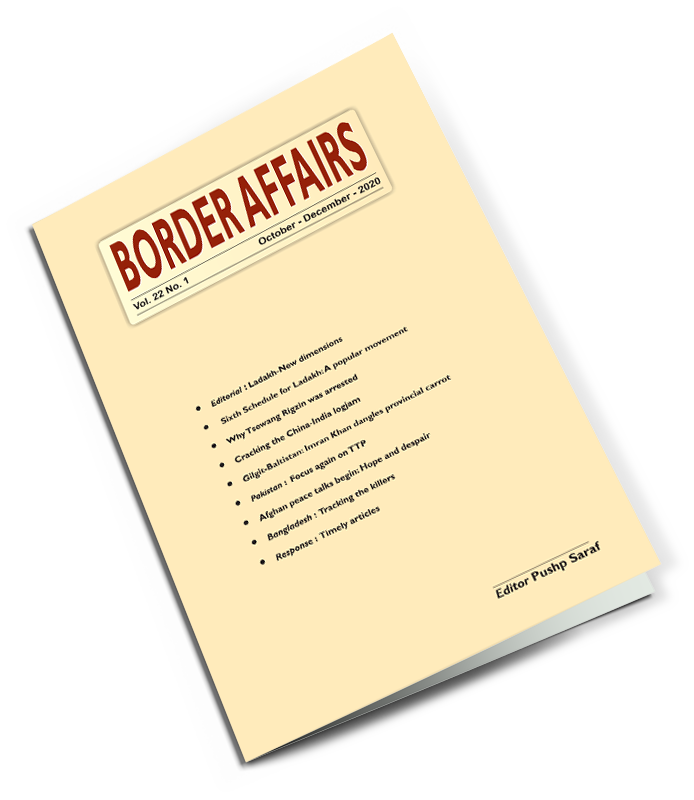Editorial
Ladakh: New dimensions

Border Affairs
- Editorial : Ladakh-New dimensions
- Sixth Schedule for Ladakh : A Popular movement
- Why Tsewang Rigzin was arrested
- Cracking the China-India logjam
- Gilgit-Baltistan : Imran Khan dangles provincial carrot
- Pakistan : Focus again on TTP
- Afghan peace talks begin : Hope and despair
- Bangladesh : Tracking the killers
- Response : Timely articles
During August and September the internal situation in Leh district of the union territory of Ladakh became quite volatile even as China continued to adopt aggressive postures on the Line of Actual Control (LAC). Such scenario could have been a cause of serious concern. Domestic tensions always come in handy for hostile elements to try to exploit for their ends. Nobody, however, believed that the situation in Leh in particular and Ladakh as a whole would deteriorate to that extent. It was because the natives of Ladakh had a rich history of proven nationalist credentials right from 1947. Their political voices at times for seeking an enhanced status within the Constitution might not be music to the ears of many at the helm. But it is a heartening reality that they have always rallied behind the armed forces as and when China and Pakistan, both of which are next door, have attempted to cross the Line of Control (LoC) and the LAC. It was just a coincidence that their latest movement for inclusion in the Sixth Schedule of the Constitution to ward off real and perceived assaults on their social, cultural, linguistic, ethnic and environmental identity after being elevated as UT on October 31, 2019 began at a time when China had openly adopted a belligerent approach. They took care to ensure that while they fought for their self-respect they did or said nothing which could harm the country’s interests. In a first-hand account Thupstan Chhewang, a leader of the movement who has been twice Lok Sabha member from Ladakh and has left electoral politics, explains the genesis and popularity of their agitation. It is to be welcomed that leaders of the movement and the Union Home Ministry have decided to sort out the issue through discussions. It shows maturity on their part. The situation had threatened to go out of hand because of certain unwarranted provocative actions and utterances of the people in authority. Peace and stability are important in border regions in particular. Inimical forces, foreign agents and infiltrators always wait in the wings to fiddle with the local sentiments. They should be given no cause of comfort. We trust that Union Home Minister Amit Shah would carry forward his timely intervention. He has committed himself to address the genuine demands of the people of Ladakh who in turn have praised him for his initial response. That he has recognised the apolitical nature of the movement is an indication that his feedback is correct. As a result of their truce the passage for the elections to the Ladakh Autonomous Hill Development Council (Leh) has been cleared. It is a matter of satisfaction. There is also merit in the understanding that gradually the scope of dialogue would have to be widened to include all stakeholders especially Kargil district, which is the other constituent of Ladakh, to find an effective and lasting solution. In another informative article which directly concerns Ladakh well-known China expert P. S. Suryanarayana has a close look at the latest moves involving India and China. He has drawn attention to several new features that have emerged in the relations between the two countries including “claim lines” that appear to have replaced the “control line.”